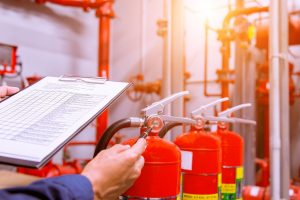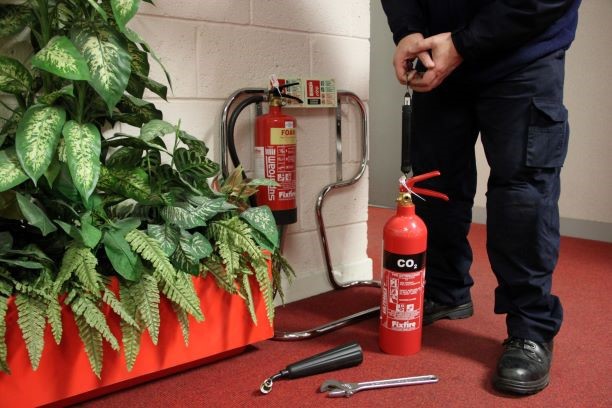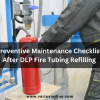![]()
Fire Immuniser
+91-7829629111
Email: info@variex.in
Varistor Technologies Pvt. Ltd.
Block-1, First Floor, Ardente Office One, Hoodi Circle, ITPL Main Road, Bengaluru, Karnataka 560048, IN
How do I know if my fire extinguisher needs to be recharged?
In the intricate tapestry of fire safety, the humble fire extinguisher emerges as a stalwart defender, standing ready to quell the flames that threaten to spiral out of control. Yet, much like any guardian, these essential devices demand periodic scrutiny to ensure their efficacy in the face of unforeseen infernos. The question that echoes in many minds is, "How do I know if my fire extinguisher needs to be recharged?" This query, often laden with uncertainty, forms the crux of our exploration into fire extinguisher maintenance—a journey to unravel the intricacies and decode the signals that herald the need for a recharge.
Whether you're a homeowner, responsible for safeguarding your family and property, a business owner tasked with protecting your assets, or simply an individual with a keen eye on safety, this guide aims to equip you with a discerning understanding of the signs and symptoms that your firefighting ally may be sending your way. Join us as we navigate through the complexities, demystifying the technicalities to empower you to keep your fire extinguisher at its zenith, perpetually prepared to tackle the unexpected conflagrations that may come your way. Together, let's decipher the subtle cues and unravel the mysteries encapsulated in the question, "How do I know if my fire extinguisher needs to be recharged?"
Role of Regular Inspections for Refilling a Fire Extinguisher
The Importance of Regular Inspections:
Regular inspections of fire extinguishers serve as the cornerstone of an effective fire safety strategy. These inspections go beyond a mere visual scan; they encompass a thorough evaluation of each component to guarantee the extinguisher's functionality. One key aspect of regular inspections involves checking the pressure gauge, which serves as an indicator of the extinguisher's internal pressure. A gauge reading outside the recommended range signals the need for immediate attention.
Additionally, inspections should include a visual examination of the extinguisher's exterior for signs of physical damage, corrosion, or leakage. The inspection process extends to verifying the accessibility of the extinguisher, ensuring it is unobstructed and easily reachable in case of an emergency. This comprehensive approach to regular inspections helps identify potential issues before they compromise the extinguisher's ability to perform effectively.
The Significance of Routine Checks:
Routine checks are akin to the daily exercises that keep an athlete in peak condition, ensuring that fire extinguishers remain in optimal shape at all times. These checks involve a quick but thorough assessment of key elements, such as confirming the extinguisher's location, inspecting the locking pin and tamper seal, and verifying the condition of the hose and nozzle. Routine checks are particularly valuable in catching minor issues early, preventing them from escalating into major problems that might compromise the extinguisher's functionality.
Optimal Frequency of Inspections:
Determining the frequency of fire extinguisher inspections is a crucial aspect of maintaining a robust fire safety protocol. Industry standards and regulations typically recommend monthly, quarterly, and annual inspections. Monthly checks are quick reviews that can be conducted by designated personnel within an organization, ensuring that extinguishers are in their designated locations and free from visible damage.
Quarterly inspections involve a more comprehensive evaluation, often performed by trained individuals or external professionals. This includes checking the pressure gauge, inspecting for corrosion or damage, and verifying that all parts are in working order. Annual inspections, which are typically more detailed, may involve a complete disassembly of the extinguisher for a thorough examination of internal components.
A Visual Inspection Checklist
Regular visual inspections are a cornerstone of maintaining the effectiveness of fire extinguishers, ensuring they stand ready for action in the event of an emergency. This comprehensive visual inspection checklist focuses on key elements, including checking the pressure gauge, examining the extinguisher's overall condition, and verifying the presence of the safety pin and tamper seal. By adhering to this checklist, individuals and organizations can proactively assess the health of their fire extinguishers, contributing to a safer environment.
1. Checking the Pressure Gauge:
The pressure gauge is a vital indicator of a fire extinguisher's internal pressure, a critical factor in its ability to discharge properly. During a visual inspection, it is imperative to verify that the pressure needle on the gauge falls within the designated range. If the needle falls outside this range, it could signify a loss of pressure, indicating the need for immediate attention and potential recharge. Regular monitoring of the pressure gauge ensures that the extinguisher remains in a state of operational readiness.
2. Examining the Extinguisher's Overall Condition:
A visual sweep of the fire extinguisher's exterior is essential for identifying signs of wear, damage, or corrosion. Any visible cracks, dents, or rust can compromise the structural integrity of the extinguisher, rendering it less effective in an emergency. Additionally, it is crucial to inspect the nozzle and hose for any kinks, blockages, or other abnormalities that might impede the flow of extinguishing agent. A thorough examination of the extinguisher's overall condition ensures that it remains both physically intact and operationally sound.
3. Verifying the Presence of the Safety Pin and Tamper Seal:
The safety pin and tamper seal are integral components that prevent accidental discharge and unauthorized use of the fire extinguisher. During the visual inspection, confirm that the safety pin is securely in place. Additionally, check for the presence and integrity of the tamper seal, which is a secondary indicator of whether the extinguisher has been used or tampered with. A missing or broken tamper seal warrants further investigation and potentially renders the extinguisher unfit for use until the issue is addressed.
Shake It Up: To Checking if Your Fire Extinguisher Needs Refilling
Shaking the Extinguisher: Unveiling the Purpose
Shaking your fire extinguisher may seem like an unconventional dance move, but it serves a vital purpose in ensuring its effectiveness. Inside the extinguisher, there's a crucial ingredient – the extinguishing powder. Over time, this powder can settle or compact due to factors like changes in temperature, vibrations, or just sitting idle for an extended period. Shaking helps break up any clumps and ensures that the powder remains free-flowing, ready to be expelled when the need arises.
Signs of Settled or Compacted Powder: What to Look For
When you give your fire extinguisher a shake, pay attention to the feedback it gives you. If the powder inside has settled or compacted, you might notice a distinct lack of movement or a solid thud rather than the expected loose, flowing sound. This lack of movement is a sign that the powder may not discharge effectively in an emergency, potentially rendering the extinguisher less reliable.
Another visual clue is to check the pressure gauge. If the needle remains in the green zone after shaking, it indicates that the pressure is sufficient. However, if the needle stays in the red, it's a signal that the extinguisher might need attention, and the powder may be compacted.
Checking Your Fire Extinguisher's Expiration Date
Your fire extinguisher, often tucked away in a corner, is a silent guardian against potential flames. But how do you ensure it's not just sitting there, but ready to leap into action when needed? One crucial aspect is understanding its lifespan and checking the expiration date. This guide navigates through the basics of the lifespan of fire extinguishers, why it matters, and how to find and interpret that often-overlooked expiration date.
Understanding the Lifespan of Fire Extinguishers:
Much like any superhero, fire extinguishers have a finite lifespan. While they don't wear capes, they do have a designated period during which they are most effective. The lifespan is influenced by various factors, including the type of extinguisher and environmental conditions. Typically, most extinguishers last between 5 to 15 years. Beyond this timeframe, their reliability and efficacy might diminish, making them less effective in an emergency.
Locating and Interpreting the Expiration Date:
Finding the expiration date on your fire extinguisher is a crucial step in ensuring its continued reliability. Manufacturers often imprint this date on the extinguisher's label, and it's usually located near the bottom. The expiration date provides a clear indication of when the extinguisher is expected to reach the end of its useful life.
Interpreting the date is straightforward. It is usually presented in a month/year format, signifying the month and year when the extinguisher is deemed to expire. For example, if the date reads "06/25," it means the extinguisher is set to expire in June 2025. Being aware of this date allows you to plan for timely replacements or refilling to maintain a dependable line of defense against potential fires.
Steps for Professional Recharge of a Fire Extinguisher
A fire extinguisher is a vital tool in our arsenal against the unpredictable threat of fires. However, like any hero, it requires periodic rejuvenation to maintain its effectiveness. Professional recharge is a crucial aspect of fire extinguisher maintenance, ensuring that it stands ready to combat flames when needed. In this guide, we'll walk through the essential steps involved in the professional recharge process, demystifying the intricacies and highlighting the importance of entrusting this task to qualified professionals.
1. Assessment of the Fire Extinguisher:
The first step in the professional recharge process involves a comprehensive assessment of the fire extinguisher. Trained technicians carefully inspect the exterior for signs of damage, corrosion, or wear. They also evaluate the condition of internal components, ensuring that the extinguisher is structurally sound and all parts are in working order.
2. Discharge and Inspection of Contents:
Before proceeding with the recharge, any remaining contents within the extinguisher are safely discharged. This step not only allows for a thorough inspection of the internal components but also ensures that the extinguishing agent is free from impurities or clumps that may have formed over time.
3. Refilling with the Correct Extinguishing Agent:
Once emptied, the fire extinguisher is refilled with the appropriate extinguishing agent. Different types of fires require different agents, and a professional recharge ensures that the extinguisher is replenished with the correct substance to effectively combat the specific types of fires it is designed for.
4. Pressurization and Sealing:
After refilling, the extinguisher undergoes pressurization. This step involves restoring the internal pressure to the recommended levels. Technicians carefully monitor this process to ensure that the extinguisher is pressurized accurately, guaranteeing optimal performance in an emergency. Subsequently, the extinguisher is sealed to prevent any leaks and maintain the integrity of the internal pressure.
5. Replacement of Safety Components:
As part of the recharge process, any safety components, such as O-rings, gaskets, and safety pins, are inspected and replaced if necessary. This step ensures that the extinguisher is equipped with all the essential safety features that contribute to its reliable functionality.
6. Final Inspection and Testing:
The professional recharge concludes with a final inspection and testing phase. Technicians perform a meticulous examination of the extinguisher, verifying that all components are in place, seals are intact, and the pressure gauge displays the correct readings. A functionality test may also be conducted to confirm that the extinguisher is ready for use in case of an emergency.
In conclusion, understanding when your fire extinguisher needs to be recharged is paramount for maintaining a robust line of defense against potential fires. The question, "How do I know if my fire extinguisher needs to be recharged?" serves as a crucial reminder to stay vigilant and proactive in ensuring the readiness of this essential safety device. Regular visual inspections, pressure gauge checks, and the occasional shake to prevent powder compaction are simple yet effective techniques that empower individuals and organizations to identify potential issues early on.
Fire extinguishers, though often overlooked, play a pivotal role in safeguarding lives and property. By staying informed and responsive to the subtle signals provided by these firefighting allies, we contribute to a safer environment for ourselves and those around us. Whether in a home, workplace, or public space, the knowledge of when and how to address the recharge needs of a fire extinguisher ensures that it remains a reliable and effective tool in times of emergency. In embracing this responsibility, we not only fortify our defenses against the unexpected but also actively participate in the collective effort to mitigate the impact of fires on our communities.
Frequently Asked Questions
1. How can I tell if my fire extinguisher needs to be recharged?
Understanding when your fire extinguisher needs a recharge involves a combination of visual inspections, pressure gauge checks, and occasionally shaking the device to ensure the extinguishing agent remains effective.
2. How often should I visually inspect my fire extinguisher?
Perform visual inspections at least once a month. Look for any signs of damage, corrosion, or wear on the extinguisher's exterior, and ensure it is easily accessible.
3. Is the pressure gauge an important indicator for recharging?
Absolutely. Check the pressure gauge regularly to ensure it falls within the recommended range. A gauge outside this range indicates a potential need for recharge.
4. Why is shaking the fire extinguisher important?
Shaking the extinguisher helps prevent the extinguishing agent from settling or compacting, ensuring it remains free-flowing and ready for effective use during an emergency.
5. Can a fire extinguisher be recharged by the user?
No, fire extinguisher recharge is a job for professionals. Attempting to recharge it without proper training and equipment may compromise its effectiveness.
Final Say
We at VariEx.in or Variexonline.com have mastered the art of designing, installing, inspecting, and fixing automatic sprinkler systems with the help of our in-house team, which is capable of delivering the fire sprinkler services you need, whether large or small and at affordable cost.
To schedule a fire sprinkler installation, or you think our services could benefit your commercial property, contact us online or give us a call at, 7829629111
"WHAT YOU CAN READ NEXT"
 Read more +24 November 2023 in Fire Extinguisher
Read more +24 November 2023 in Fire ExtinguisherWhat types of fire extinguishers are available for different fire classes?
 Read more +11 July 2025 in Fire Suppression
Read more +11 July 2025 in Fire Suppression







